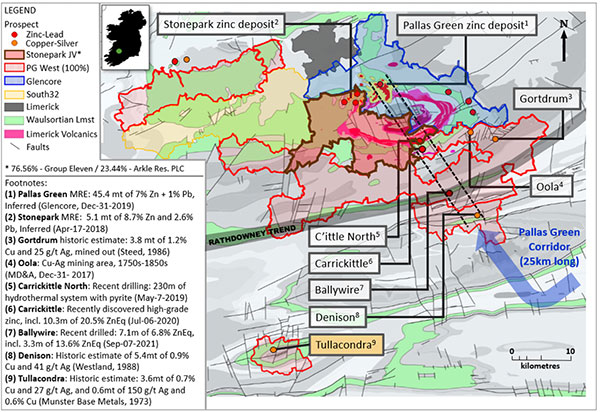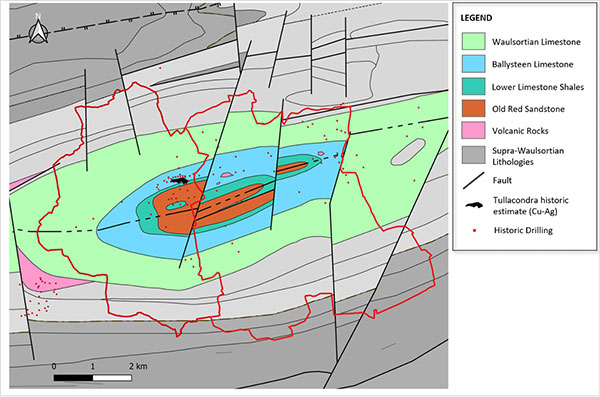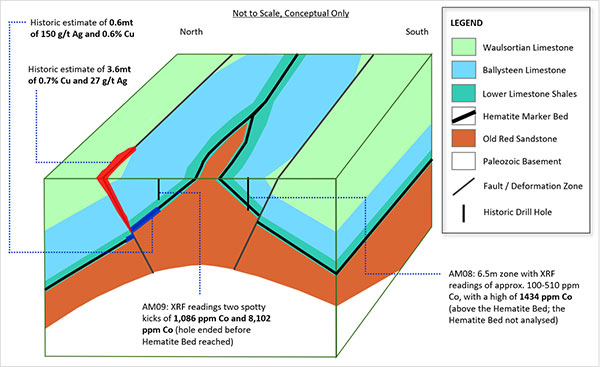Group Eleven Starts Drilling at Stonepark Project, Plans Maiden Drilling at Tullacondra Prospect, PG West Project, Ireland
Vancouver, Canada, February 02, 2022 - Group Eleven Resources Corp. (TSX-V: ZNG; OTC: GRLVF; FRA: 3GE) (“Group Eleven” or the “Company”) is pleased to announce that drilling has started on its Stonepark project (“Stonepark”, 76.56% Group Eleven, 23.44% Arkle Resources PLC), Ireland. Separately, plans for the Company’s initial drilling at the recently staked Tullacondra Copper-Silver Prospect (“Tullacondra”), near the PG West Project (“PG West”), are also underway.
Highlights:
- First hole of a six-hole program at Stonepark (totalling 2,300m; see news release dated January 19, 2022) began yesterday at the Carrickittle North locality
- With a target depth of 750m, this hole represents a 250m step-out from previous drilling, targeting the unexplored southern margin of the Limerick Volcanic Complex, which management believes has the potential to host zinc mineralization similar to Glencore’s nearby Pallas Green zinc-lead deposit1
- Separately, at Tullacondra, the Company is finalizing plans to drill one hole (approx. 150m depth), starting in the next 4-8 weeks
- Tullacondra hosts a historic estimate2 of copper and silver (from 1973) and, from regional drilling in 2012 by a previous operator, also appears to contain elevated cobalt levels (based on XRF data, which have yet to be confirmed and followed-up)
- Historic core from Tullacondra cannot be located (assumed lost and/or discarded) and historic data is quite limited (containing only four elements: Cu, Ag, Zn, Pb)
- Hence, the aim of Tullacondra drilling will be to ascertain how mineralization at the prospect compares to Group Eleven’s other Cu-Ag prospects (Gortdrum, Denison and Oola) and try to determine if the prospect has potential for economic cobalt mineralization
- Above work will help determine how Tullacondra ranks versus other prospects in terms of exploration potential and may offer insights into ongoing exploration at the Stonepark and PG West projects
“We are excited to begin our drill hole at Carrickittle North, targeting similar structure and geology to Glencore’s Pallas Green zinc deposit, located less than 10 kilometres along trend to the north. We also very much look forward to conducting our long-awaited drilling at Tullacondra,” stated Bart Jaworski, CEO. “With strong, near-surface copper-silver mineralization over hundreds of metres of strike, Tullacondra has been in our sights for a long time. Aside from trying to find look-alike zones of mineralization in the neighbourhood, it is equally intriguing that the prospect’s potential for cobalt has never been advanced and yet, may provide a brand-new avenue for exploration on the property.”
Background Information on the Tullacondra Prospect at the PG West Project (100%-interest), Ireland
The Tullacondra prospect is located approximately 20km south of the Company’s PG West project (see Exhibit 1). Group Eleven applied for the Tullacondra property in early 2020 and was granted the prospecting licenses in Sept 2020. The prospect shares similarities to Group Eleven’s Gortdrum, Denison and Oola Cu-Ag prospects, especially given that mineralization appears to be related to volcanics. Located 1km to the east of the Tullacondra historic estimate, for example, an exposure of pyroclastic volcanic material (see Exhibit 2) is believed to represent a larger volcanic vent breccia, with the age of volcanism believed to be similar to that at Group Eleven’s Stonepark and PG West projects.
Tullacondra hosts two adjacent and distinct historic estimates: (a) 3.6 million tonnes of 0.7% copper and 27 g/t silver (“copper-rich zone”); and (b) 0.6 million tonnes of 150 g/t silver and 0.6% copper (“silver-rich zone”; see Exhibits 2 and 3). The historic estimates at Tullacondra were first reported by Munster Base Metals Ltd. in 1973 and later summarized by Wilbur and Carter in 1985; the historic estimates have not been verified as current mineral resources; none of the key assumptions, parameters and methods used to prepare the historic estimates were reported and no resource categories were used; significant data compilation, re-drilling and data verification may be required by a Qualified Person before the historic estimates can be verified and upgraded to be compliant with current NI 43-101 standards; a Qualified Person has not done sufficient work to classify them as a current mineral resource and the Company is not treating the historic estimates as current mineral resources.
The copper-rich zone occurs as a near-vertical body (see Exhibit 3) approximately 25-40m thick, extending from near-surface to a vertical depth of at least 120m and extending for a strike length of 370m in an E-W orientation. Mineralization is composed predominantly of bornite and chalcopyrite (occurring as small veins, disseminations and blebs) and mostly hosted in carbonate (limestone) lithologies above the Old Red Sandstone (albeit, some mineralization appears to also occur deeper in the stratigraphy).
The silver-rich zone occurs as a gently-dipping, strata-bound horizon (see Exhibit 3; approximately 5-10m thick, 300m strike length, 250m dip extent), occurring at the base of the copper-rich body. Mineralization consists predominantly of tennantite-tetrahedrite and native silver (highest grade attained historically was 426 g/t Ag over 1.5m). The silver-rich horizon occurs along a distinctive hematite-bearing (iron oxide rich) marker horizon. This horizon is about 30cm thick, albeit varies in thickness, and is observed throughout the property.
In 2012, a previous operator focussing on Cu-Ag exploration, drilled five regional holes within several kilometres of the historic estimate, intersecting the hematite horizon within three of the holes (the two others were abandoned prior to reaching the hematite horizon). XRF analysis was conducted on portions of each hole (X-ray fluorescence is a quicker and less expensive alternative to traditional laboratory assay).
Two of these holes returned strongly elevated cobalt levels. ‘AM08’ returned a 6.5m zone (starting at a downhole depth of 15.0m) with consistently elevated cobalt readings generally ranging between 100-510 ppm, with a high of 1434 ppm Co; whereas, ‘AM09’ returned much spottier readings, albeit, containing two strong kicks of 1,086 ppm Co and 8,102 ppm Co at a depth of 18.00m and 19.5m, respectively3. Given the XRF program was quite limited (restricted to the first several metres of each hole), the above readings were inadvertently collected proximal to the hematite horizon, but not at the hematite horizon itself.
Given the low prices at the time, cobalt was not a focus. Similarly, the Tullacondra historic estimate has never been analysed for cobalt (historic assays consist only of Cu, Ag, Zn and Pb). Further work is required to determine the nature and extent of cobalt mineralization on the property and to determine if such mineralization might be present at the historic estimate, within the hematite-layer and/or potentially elsewhere on the property.
Exhibit 1. Location of Tullacondra (100% interest) Prospect, Near Stonepark and PG West Projects
Notes to Exhibit 1: (a) Pallas Green MRE is owned by Glencore; (b) Stonepark MRE: please refer to the NI 43-101 Independent Report on the Zinc-Lead Exploration Project at Stonepark, County Limerick, Ireland, with an effective date of April 26, 2018, as found on SEDAR; (c) the historic estimate at Denison was reported by Westland Exploration Limited in 1988, the historic estimate at Tullacondra was reported by Munster Base Metals Ltd in 1973 and the historic estimate at Gortdrum was reported by G.M. Steed in 1986; these three historic estimates have not been verified as current mineral resources; none of the key assumptions, parameters and methods used to prepare the historic estimates were reported and no resource categories were used; significant data compilation, re-drilling and data verification may be required by a Qualified Person before the historic estimates can be verified and upgraded to be compliant with current NI 43-101 standards; a Qualified Person has not done sufficient work to classify them as a current mineral resource and the Company is not treating the historic estimates as current mineral resources.
Exhibit 2. Plan Map of the Tullacondra Cu-Ag Prospect (100%-interest), Ireland
Exhibit 3. Simplified Conceptual Block Model of Tullacondra Cu-Ag Prospect (100%-interest), Ireland
Note: Modified from Diversified Asset Holdings (2016)
Qualified Person
Technical information in this news release has been approved by Paul Gordon, P.Geo., geological consultant at SLR Consulting, and independent ‘Qualified Person’ as defined under Canadian National Instrument 43-101.
About Group Eleven Resources
Group Eleven Resources Corp. (TSX.V: ZNG; OTC: GRLVF and FRA: 3GE) is a mineral exploration company focused on advanced stage zinc exploration in Ireland. Additional information about the Company is available at www.groupelevenresources.com.
ON BEHALF OF THE BOARD OF DIRECTORS
Bart Jaworski, P.Geo.
Chief Executive Officer
E: b.jaworski@groupelevenresources.com | T: +353-85-833-2463
E: s.heinrichs@groupelevenresources.com | T: +604-630-8839
Neither TSX Venture Exchange nor its Regulation Services Provider (as that term is defined in the policies of the TSX Venture Exchange) accepts responsibility for the adequacy or accuracy of this release.
Cautionary Note Regarding Forward-Looking Information
This press release contains forward-looking statements within the meaning of applicable securities legislation. Such statements include, without limitation, statements regarding the future results of operations, performance and achievements of the Company, including the timing, content, cost and results of proposed work programs, the discovery and delineation of mineral deposits/resources/ reserves and geological interpretations. Although the Company believes that such statements are reasonable, it can give no assurance that such expectations will prove to be correct. Forward-looking statements are typically identified by words such as: believe, expect, anticipate, intend, estimate, postulate and similar expressions, or are those, which, by their nature, refer to future events. The Company cautions investors that any forward-looking statements by the Company are not guarantees of future results or performance, and that actual results may differ materially from those in forward looking statements as a result of various factors, including, but not limited to, variations in the nature, quality and quantity of any mineral deposits that may be located. All of the Company's public disclosure filings may be accessed via www.sedar.com and readers are urged to review these materials, including the technical reports filed with respect to the Company's mineral properties.
1 Resources and Reserves Report (Glencore, December 31, 2020) – 45.4 million tonnes of 7% Zn + 1% Pb (Inferred)
2 3.6mt of 0.7% Cu and 27 g/t Ag and 0.6mt of 150 g/t Ag and 0.6% Cu (Source: Munster Base Metals Ltd., 1973; Wilbur and Carter, 1985)
3 Report by Mayfly Resources Ltd. (dated 20 May 2013) – XRF readings were taken every 5cm and averaged for each 50cm interval;




